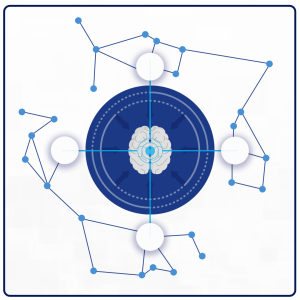Graph Analytics: The Future in Data Science?
4 min read


Data leaders are currently facing the challenge of not only managing large volumes of data, but also extracting meaningful insights from that data. In many cases, the connections and relationships between data points are more important than the data points themselves. To effectively analyze and understand complex datasets, organizations need to use graph database technology to capture those relationships.
Many organizations currently rely on Relational Database Management Systems (RDBMS) to store their structured data. However, the fixed and inflexible structure of RDBMS can make it difficult to capture and represent the complex relationships between data points. As a result, these systems are often inadequate.

Graph databases are designed to efficiently store and query connected data by using a node and relationship-based format, making them particularly equipped to solve problems when understanding those connections are critical.
One of the key advantages of graph databases is that they can mimic the way the human brain processes and understands associations. By representing data as nodes and relationships, graph databases provide a more intuitive and natural way of working with connected data.
However, before this data can be analyzed and queried, it often needs to be migrated and prepared for use with a graph database. This process, known as data orchestration, involves cleaning and organizing the data, as well as defining the relationships between different data points.
To fully leverage the power of graph analytics, organizations need to develop a robust data orchestration strategy that ensures their data is clean, organized, and ready to use. This can be a challenging task for many organizations, especially at a large scale.

The data orchestration process often involves a range of activities, such as discovering, ingesting, profiling, tagging, and transforming data. At a large scale, this journey can take months or even years to be completed.
To make the process more efficient, organizations need a modern data platform that can support their data preparation and orchestration efforts. By using graph database technology, organizations can ensure their data is ready for analysis and can be easily queried.
How Graph Analytics Simplifies Data Visualization
Graph analytics provide a visual representation of data and relationships between data elements. This visualization allows data scientists and analysts to quickly understand the structure and content of their data, and to identify patterns and trends that may not be immediately apparent from looking at raw datasets.
With graph analytics, data scientists and analysts can create visually appealing and intuitive data visualizations using graphs, charts, and maps. This helps effectively communicate and share insights with others and can facilitate collaboration and
decision making within an organization.
In addition, graph analytics provide real-time insights into the performance and efficiency of data visualization, allowing the end user to identify and address potential issues before they impact the overall effectiveness of their research.
Ultimately, graph analytics is an invaluable tool for data analysis.

Modak + Neo4j: Data Orchestration and Graph Analytics
Modak Nabu™ is a modern data engineering platform that significantly speeds up data preparation and improves the performance of analytics. It achieves this by converging a range of data management and analytics capabilities, such as data ingestion, profiling, indexing, curation, and exploration.
Neo4j is a leading graph data platform for building intelligent applications. It is the only enterprise-grade graph database that offers native graph storage, a scalable and performance-optimized architecture, and support for ACID compliance. By using Neo4j, business teams can easily work with connected data and reduce complex and time-consuming queries.
Together, Modak Nabu™ and Neo4j provide a powerful solution for data preparation, visualization, and orchestration, enabling organizations to prepare their data quickly and effectively for analysis using graph technology.

The partnership between Modak and Neo4j brings significant benefits to enterprises across industries. Graph visualization enables faster relationship and pattern discovery in datasets, while the Cypher query language simplifies querying. It yields consumption-ready curated data products, provides self-service data engineering using a no-code/low-code platform, and supports multi-cloud and hybrid-cloud data engineering.
This partnership allows enterprises to take advantage of the powerful data management and analysis capabilities of both Modak Nabu™ and Neo4j, and drive greater business value from their data, lowering costs and accelerating this complex process.
About Modak
Modak is a solutions company that enables enterprises to manage and utilize their data landscape effectively. We provide cloud-agnostic software and services to accelerate data migration initiatives. We use machine learning (ML) techniques to transform how structured and unstructured data is prepared, consumed, and shared.
Modak’s portfolio of Data Engineering Studio provides best-in-class delivery services, managed data operations, data mesh, data fabric, augmented data preparation, data quality, and governed data lake solutions.










